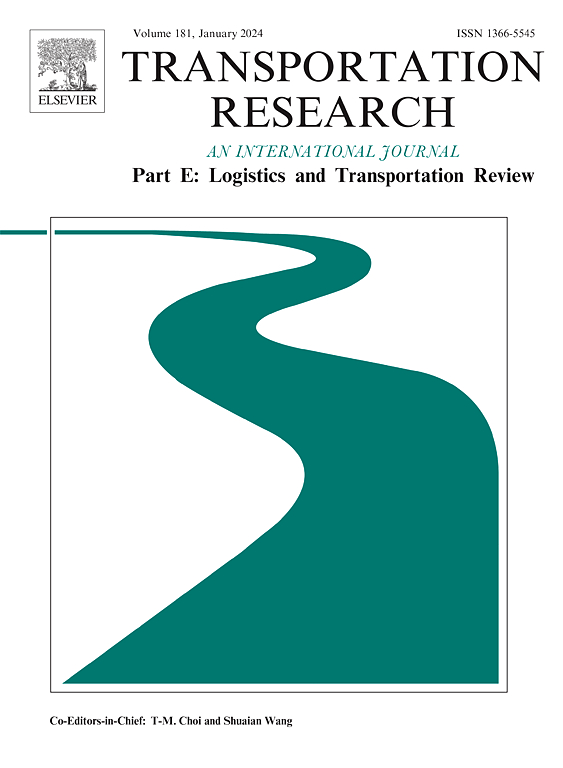Centralized and decentralized supply chains: Performance maps for comparing the cost-effectiveness of distribution network configurations
IF 8.8
1区 工程技术
Q1 ECONOMICS
Transportation Research Part E-Logistics and Transportation Review
Pub Date : 2025-09-29
DOI:10.1016/j.tre.2025.104435
引用次数: 0
Abstract
Optimizing Distribution Networks (DNs) is crucial for retailers, impacting service levels and logistics costs. A key DN configuration decision is the stock deployment policy, which entails choosing between centralized, decentralized, and hybrid DNs for each Stock Keeping Unit (SKU). Choosing the stock deployment policy is complex due to many variables influencing the decision (e.g., number of customers served, SKU purchasing costs, customer demand, etc.). Moreover, this decision must be revisited whenever customer demands changes, which can be time-consuming when DN resilience is challenged by geopolitical changes, market trends, and disruptive events. Dimensional Analysis (DA), and particularly the Buckingham Theorem (BT), shows capabilities to support retailers in guiding and streamlining stock deployment decisions. After modeling the stock deployment problem in a mathematical form, BT can identify its influential variables, extract knowledge on how variables mutually interact when affecting the stock deployment performance, and aid informed decision-making on the most cost-effective policy. Accordingly, BT enables creating performance maps which compare the characteristics of different DNs and SKUs, then suggesting similar stock deployment decisions for similar (scaled) DNs and SKUs. Despite the potential utility of these performance maps, no prior study has explored BT’s capabilities for stock deployment decisions. This paper bridges this gap by proposing BT to create supportive maps for multidimensional scaling, similarity analysis, and economic performance prediction across centralized, decentralized, and hybrid DNs. The resultant maps provide retailers with visual decision support tools for associating similar DNs and SKUs with optimal stock deployment policies, ultimately improving DN performance and resilience.
集中式和分散式供应链:用于比较分配网络配置的成本效益的绩效图
优化分销网络(dn)对零售商来说至关重要,影响着服务水平和物流成本。一个关键的DN配置决策是库存部署策略,它需要为每个库存单元(stock Keeping Unit, SKU)选择集中式、分散式和混合式DN。选择库存部署策略是复杂的,因为影响决策的变量很多(例如,服务的客户数量、SKU采购成本、客户需求等)。此外,每当客户需求发生变化时,都必须重新考虑此决策,当DN弹性受到地缘政治变化、市场趋势和破坏性事件的挑战时,这可能会很耗时。量纲分析(DA),特别是白金汉定理(BT),显示了支持零售商指导和简化库存部署决策的能力。通过对库存部署问题进行数学建模,BT可以识别其影响变量,提取变量在影响库存部署绩效时如何相互作用的知识,并帮助制定最具成本效益的政策。因此,BT可以创建性能映射,比较不同DNs和sku的特征,然后为类似的(缩放的)DNs和sku提出类似的库存部署决策。尽管这些性能图具有潜在的效用,但之前没有研究探索过BT在库存部署决策方面的能力。本文通过建议BT创建跨集中式、分散式和混合式DNs的多维缩放、相似性分析和经济性能预测的支持性地图,弥合了这一差距。生成的映射为零售商提供了可视化的决策支持工具,将类似的DN和sku与最佳库存部署策略关联起来,最终提高DN的性能和弹性。
本文章由计算机程序翻译,如有差异,请以英文原文为准。
求助全文
约1分钟内获得全文
求助全文
来源期刊
CiteScore
16.20
自引率
16.00%
发文量
285
审稿时长
62 days
期刊介绍:
Transportation Research Part E: Logistics and Transportation Review is a reputable journal that publishes high-quality articles covering a wide range of topics in the field of logistics and transportation research. The journal welcomes submissions on various subjects, including transport economics, transport infrastructure and investment appraisal, evaluation of public policies related to transportation, empirical and analytical studies of logistics management practices and performance, logistics and operations models, and logistics and supply chain management.
Part E aims to provide informative and well-researched articles that contribute to the understanding and advancement of the field. The content of the journal is complementary to other prestigious journals in transportation research, such as Transportation Research Part A: Policy and Practice, Part B: Methodological, Part C: Emerging Technologies, Part D: Transport and Environment, and Part F: Traffic Psychology and Behaviour. Together, these journals form a comprehensive and cohesive reference for current research in transportation science.

 求助内容:
求助内容: 应助结果提醒方式:
应助结果提醒方式:


